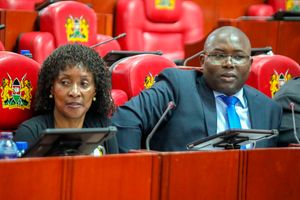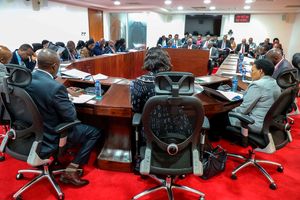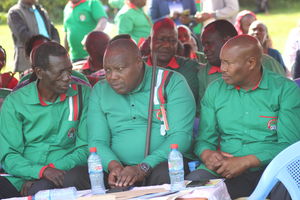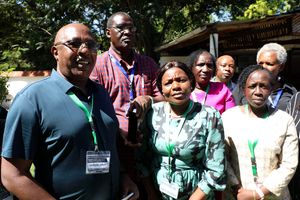
The Teachers Service Commission (TSC) headquarters in Upper Hill, Nairobi.
More than 23,000 teachers, whose promotions have been pending following investigations by Parliament, are now set for higher job grades and enhanced salaries.
This is after the National Assembly’s Education Committee gave the Teachers Service Commission (TSC) the green light to process their job-grade elevation.
For close to two months, the 23,388 teachers have been waiting for their fate since their employer announced their new statuses on April 2, 2025.
The House Education committee slammed brakes on the promotions following allegations of impropriety in the process and launched investigations into the matter.
The MPs have now directed that 1,864 teachers be struck off the promotions list after it emerged that they were promoted before they served in their current job grades for three years, as demanded by the TSC regulations on promotions.
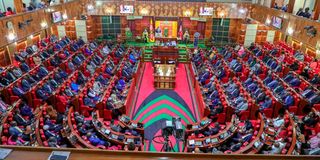
The National Assembly during a sitting.
The Nation on Wednesday established that the resolution was reached during a closed-door meeting between the MPs and TSC commissioners.
The chairman of the House committee, Mr Julius Melly, confirmed to the Nation that the promotions would take effect immediately.
Also Read: Uproar as TSC promotes 25,000 teachers
The committee also recommended that qualified teachers from populous counties be considered for more promotions on a pro-rata basis to achieve equity, with teachers who have served for seven years in one grade and have three years to retire from service getting priority.
During the MPs’ investigations, the TSC informed the committee that 5,291 teachers were promoted without the requisite three years’ service in their current job grade.
Of these, the commission pleaded with the MPs to retain 3,427 teachers who are in grades D3 (principals) and C4 (deputy principals).
According to TSC data, the two job grades did not attract enough applicants, yet they are crucial in the administration of schools and succession plans.
“In a nutshell, the two grades, which are administrative positions, did not have sufficient qualified teachers nationally. As a result, the commission waived the three years’ requisite service in one grade before promotion and substituted it with six months’ service,” the commission said in its submission.
Need basis
The committee had tasked the TSC to provide evidence of an actual teacher shortage in the pool of eligible teachers for promotions to justify its decision to relax the three-year rule as stipulated in the Career Progression Guidelines.
In response to this, the TSC highlighted that prior to publishing the advert in November last year, it had conducted an analysis of its database to determine the adequacy of potential applicants who had completed the requisite three years.
The analysis TSC says showed some 1,410 vacancies that had arisen in Grade D3, with its database showing that only 598 teachers had served for three years and above in grade D2 as at the date of the advert and were therefore eligible for promotion.
For Grade C3, the commission database showed 7,460 teachers had served in the position for three years and thus eligible for promotion against some 3,386 vacancies declared for deputy headteacher in Grade C4.
“The commission made a policy decision to temporarily waive the three-year requisite service in one grade and instead allow teachers with a minimum of six months' service to apply in the two grades,” the TSC said.
As a result of the waiver, Grade D3 attracted 1,694 applicants against 1,410 available vacancies while Grade C4 attracted 4,521 applicants against 3,686 available vacancies.
For the deputy principal III (Grade D1) position, the TSC waived the three-year requirement for 18 counties— including Migori, Busia, Bomet, Homa Bay, Kwale and Mandera.
The TSC maintained that as a standard practice, it shortlists at least three candidates for every advertised vacancy so as to uphold competitiveness and ensure that the best-suited candidates are selected.
Subsequently, following the November 2024 advertisement, a total of 1,410 were promoted in grade D3 (principals) and 3,686 were promoted in grade C4 (deputy headteacher) positions across the country.
Aside from waiving the three-year rule to address the perennial problem of teachers acting in administrative positions, the TSC highlighted that it was also done to address a shortage of applicants, especially in Arid and Semi-Arid Lands (ASAL) and hard-to-staff areas.
The TSC said an analysis of the current staffing situation in ASAL counties and other listed hard-to-staff areas shows that institutional administrators are performing in lower grades that do not match the level of responsibility they carry.
Additionally, the analysis showed that the administrators, the majority of whom serve in grades C2, C3, C4 and C5 rather than the required D grades for principals and deputy principals, were not earning acting allowances or special duty allowances.
The National Assembly had appropriated Sh1 billion for promotion of teachers, a budgetary allocation the TSC says could only promote 5,690 teachers.
The balance of 19,598 vacancies, the commission says, arose out of exits from the current financial year ending June 30, 2025.
During a previous meeting on April 14, 2025, members of the committee accused the TSC of using an opaque criteria and failing to uphold principals of equity.
The data presented by TSC shows four ethnic communities—Kikuyu, Kalenjin, Luhya, Kamba and Luo—secured more than two-thirds of all promoted-teacher slots, raising questions over ethnic balance in the appointments.
The revelations come on the backdrop of similar concerns raised by the Senate Committee on National Cohesion, Equal Opportunity and Regional Integration on skewed ethnic representation in the hiring of Junior School teachers, with TSC defending itself— citing the availability of qualified applicants per region and subject area as the driving factor.
The figures tabled before the committee last week suggest 65 percent of the 25,252 teachers promoted went to individuals from the five communities alone, with the Gikuyu taking the lion’s share at 18.3 percent (4,646), despite accounting for 17.1 percent of Kenya’s population.
The TSC data shows the Kalenjin come in second at 15.8 percent (4,003), the Luhya community at 12.4 percent (or 3,148), followed by Luos at 9.4 percent (2,388) and the Kambas at nine percent (2,280).

